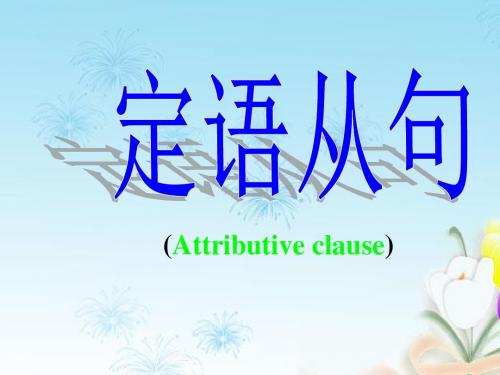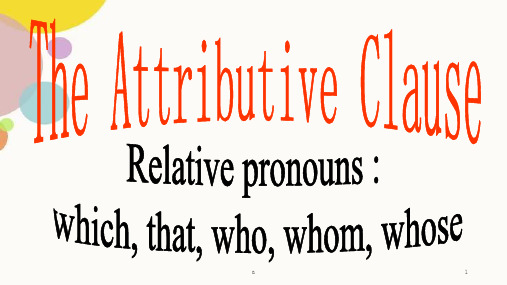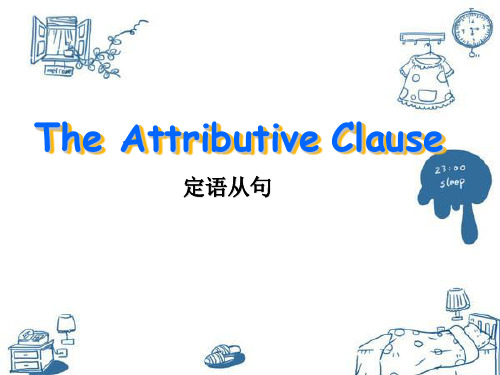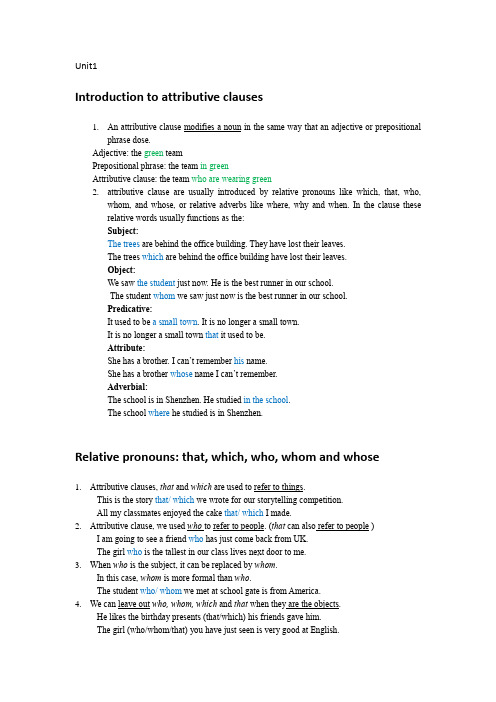定语从句全英文版讲解的attributive
- 格式:ppt
- 大小:1.16 MB
- 文档页数:18


定语从句定语从句(Attributive Clauses)在句中做定语,修饰一个名词或代词,有时也可以修饰部分或整个句子。
被修饰的名词,词组或代词即先行词。
定语从句通常出现在先行词之后,由关系词(关系代词或关系副词)引出。
关系代词有:who,whom,whose,that,which,as。
关系副词有:when,where,why,how。
关系代词和关系副词放在先行词和定语从句之间,起连接作用,同时又可做定语从句的一个成分。
当关系代词做宾语时可以省略。
定语从句中的谓语动词必须在人称上和数量上和先行词保持一致。
定语从句分为限制性定语从句和非限制性定语从句。
一、定语从句的翻译许多英语初学者往往弄不明白为什么引导定语从句的关系词which不能译为“哪一个”,who不能译为“谁”,when不能译为“什么时候”,where不能译为“什么地方”,等等。
首先,我们必须要明白一点,那就是引导定语从句的which,who,when,where,why等是关系词(关系代词或关系副词),而不是疑问词,所以不能按疑问词的意思来理解。
前面我们讲到,英语中的定语从句总是后置的,即要放在被修饰名词或代词之后;但在汉语中,定语通常是前置的,也就是说定语要放在被修饰名词的前面,并通常表现为“……的”这样的形式。
当我们翻译英语中定语从句的时候,一般可以按汉语习惯,将定语从句翻译在被修饰的名词或代词之前,而其中的关系词一般就是译成汉语中的“……的”。
如:He showed me the article that he had written.他把他写的文章拿给我看。
句中的that he had written为修饰名词the article的定语从句,翻译时就可译为“他写的文章”,其中的关系代词that在此译成了“的”字。
She was not in the train which arrived just now.她不在刚到的那列火车上。



Unit1Introduction to attributive clauses1.An attributive clause modifies a noun in the same way that an adjective or prepositionalphrase dose.Adjective: the green teamPrepositional phrase: the team in greenAttributive clause: the team who are wearing green2.attributive clause are usually introduced by relative pronouns like which, that, who,whom, and whose, or relative adverbs like where, why and when. In the clause these relative words usually functions as the:Subject:The trees are behind the office building. They have lost their leaves.The trees which are behind the office building have lost their leaves.Object:We saw the student just now. He is the best runner in our school.The student whom we saw just nowis the best runner in our school.Predicative:It used to be a small town. It is no longer a small town.It is no longer a small town that it used to be.Attribute:She has a brother. I can’t remember his name.She has a brother whose name I can’t remember.Adverbial:The school is in Shenzhen. He studied in the school.The school where he studied is in Shenzhen.Relative pronouns: that, which, who, whom and whose1.Attributive clauses, that and which are used to refer to things.This is the story that/ which we wrote for our storytelling competition.All my classmates enjoyed the cake that/ which I made.2.Attributive clause, we used who to refer to people. (that can also refer to people )I am going to see a friend who has just come back from UK.The girl who is the tallest in our class lives next door to me.3.When who is the subject, it can be replaced by whom.In this case, whom is more formal than who.The student who/ whom we met at school gate is from America.4.We can leave out who, whom, which and that when they are the objects.He likes the birthday presents (that/which) his friends gave him.The girl (who/whom/that) you have just seen is very good at English.5.We use whose to mean possession. (所属) It usually relates to a person, but it can also relateto things.I sat next to a girl whose name was Diana.The club whose members are music fans meet in the school garden every Saturday afternoon. Unit2Preposition + which and preposition + whom1.We use preposition to begin an attributive clause when the relative pronoun (which/whom) isthe object of the Preposition.We could expect good decision from you. We thought you were such a person.We thought you were such a person from whom we could expect good decision.You were too buy dog food with the money. The money is gone.The money with which you were too buy dog food is gone.2.In inform English, thePreposition is usually at the end of the attributive clause.The Maths teacher is the person whom I got an A’from.Literature is a subject which I know little about.3.If the preposition is at the end of the attributive clause, whom and which can be replacedby that, and whom can also be replaced by who.Dad is a person whom/ that/ who I can easily talk to.Is this the play which/that you were talking about just now?4.We often leave out which or whom in an attributive clause when the relative pronoun is theobject of the Preposition and when the Preposition is at the end of the attributive clause.The subject (which) Eric s interested in is Physics.Daniel is the person (whom) I want to make friends with.5.We use that or in which to begin an attributive clauseafter way.In this case, that or in whichcan also be left out.Ididn’t like the way (that/in which) she talked to me.Relative adverbs: when, where, why1.We often use relative adverb when to begin attributive clauseafter nouns like time, moment,day, season, and year.Do you remember the day when we left you in charge?I often think of the moment when I first saw her.Iremember the time when Eric won that speech completion.2.We often use the relative adverb where to begin attributive clauseafter nouns like place, house,city, country and world.This is not a family where bad behavior can be tolerated.3.We use the relative adverb why to begin attributive clauseafter reason.Idon’t know the reason why the house is so dirty.4.In more formal English, where, when and why can sometimes be replaced by a Preposition +which.The study is the place where/in which I often have talks with my father.This is the reason why/ for which my parents got home earlier.It rained the whole day when/ on which he travelled with his family.Unit 3Non-restrictive attributive clauses1. A non-restrictive attributive clauseadds extra information to the main clause of a sentence.There is usually a comma before it.(We can use who, whose, which, where and when but not that to begin a non-restrictive attributive clause.)Amy, who took weight-loss pills, now realizes that health is important.My cousin, whose body is slim, still wants to lose some weight.I am taking some weight-loss pills, which are quite popular here.My pills are in the bedroom, where I always keep them.We’ll put off the outing until next month, when Amy feels better.2.We can use which to refer to the main clause as a whole.He missed the show, which was a great pity.3.We use all/ some of + whom/which to talk about part or all of something.I’m doing different types of exercises, all of which are quite helpful to my health.Many people, some of them are not overweight, are going on a diet.Question tagsQuestion tagsare short questions that come at the end of statements. They are often used in spoken English to start a conversation, to ask for information in a polite way, or to ask someone politely to do something. We use them to ask for agreement or confirmation.Asking for agreementWhen we use a question tag to ask for agreement, we expect the other person to agree with us. Used for this purpose, the question tag has falling intonation.You still go to the gym every day, don’t you?Asking for confirmationWhen we use a question tag to ask for confirmation, we are asking about something we are not sure about. Used for this purpose, the question tag has rising intonation.You still go to the gym every day, don’t you?There are different ways to form question tags.1.At the end of a positive statement, we use a negative question tag.At the end of a negative statement, we use a positive question tag.We can still be friends, can’t we?He doesn’t like the cream, does he?2.When the main clause uses words like neither, none, nobody, nothing, few, little, never, hardlyor seldom, it is usuallyconsidered negative. It is, therefore, followed by a positive question tag.Neither of you will have coffee, will you?No one has found my CD, have they?His sister seldom argues with people, does she?(When the main clause uses little to mean small or young, it is considered positive: There are a group of little children in the museum, a ren’t there?)3.We use a personal pronoun like I, we, you, he, she, it or they in a question tag.I was pretty silly, wasn’t I?His father can’t name the plant, can he?You wouldn’t like to take these pills, would you?Everyone has advised you not to go on a diet, haven’t they?4.We use an auxiliary verb, modal verb or be in a question tag.You like travelling, don’t you?There is something wrong,isn’t there?You can’t speak Italian, can you?5.After an imperative clause, we often use will you. However, after Let’s, we use shall we.Post a letter for me, will you?Let’s have a break, shall we?Unit 4Present perfect tense1.We use the present perfect tense to talk about things that happened in the recent past but areconnected with the present.Justin has disappeared, so Kelly is very sad.2.We also use the present perfect tense to talk about something that started in the past and is stillhappening now.I have not seen Justin since last Friday night.3.We use present perfect tensewhen the exact time of an action is not clear or important.We useit with time expression such as:already ever for just lately never recently since yet(when the time of an action is given, we use past tense: Justin disappeared last Friday night. )We use already for affirmative statements and yet for negative statements.The boy has already come home.I haven’t heard anything from him.We use for + a period of time and since + a point in time.We haven’t seen him for two days.We haven’t seen him since last Monday.4.We use the present perfect tense to talk about actions that were completed only a short timeago.The police have just finished searching the area.5.We can also use the present perfect tensefor repeated actions.Some villagers say that they have seen UFOs many times.Present perfect or Present perfect continuous?1.We use present perfect tense to talk about an action completed in the recent past, and thePresent perfect continuous tense for an action started in the past and is still happening.Li jia has read a book about Stonehenge. (she finished reading the book.)Li jia has been reading abook about Stonehenge.。

Attributive Clause定语从句关于定语从句定语从句及相关术语1.定语从句:定语从句是由关系代词或关系副词引导的从句,其作用是作定语修饰主句的某个名词性成分,相当于形容词,所以又称为形容词性从句,一般紧跟在它所修饰的先行词后面。
2.关系词:引导定语从句的关联词称为关系词,关系词有关系代词和关系副词。
关系代词有that, which, who, whom, whose, as等;关系副词有where, when, why等。
关系词常有3个作用:1,引导定语从句。
2,代替先行词。
3,在定语从句中担当一个成分。
3.定语:定语用来限定、修饰名词或代词的,是对名词或代词起修饰、限定作用的词、短语或句子,汉语中常用………的‟表示。
主要由形容词担任。
此外,名词,代词,数词,分词,副词,不定式以及介词短语也可以来担任,也可以由一个句子来担任.单词作定语时通常放在它所修饰的词之前,作前置定语。
短语和从句作定语时则放在所修饰的词之后,作后置定语。
(一)限定性定语从句1. that既可代表事物也可代表人,which代表事物;它们在从句中作主语或宾语,that在从句中作宾语时常可省略关系词,which在从句中作宾语则不能省略。
而且,如果which在从句中作“不及物动词+介词”的介词的宾语,注意介词不要丢掉,而且介词总是放在关系代词which的前边,但有的则放在它原来的位置2. which作宾语时,根据先行词与定语从句之间的语义关系,先行词与which之间的介词不能丢3. 代表物时多用which,但在带有下列词的句子中用that而不用which,这些词包括当先行词是anything, everything, nothing ,few, all, none, little, some等代词时,或者是由every, any, all, some, no, little, few, much等修饰时等,这时的that常被省略4. who和whom引导的从句用来修饰人,分别作从句中的主语和宾语,whom作宾语时,要注意它可以作动词的宾语也可以作介词的宾语5. where是关系副词,用来表示地点的定语从句6. when引导定语从句表示时间[注]值得一提的是,表示时间“time"一词的定语从句只用when 引导,有时不用任何关系代词,当然也不用that引导By the time you arrive in London, we will have stayed there for two weeks. I still remember the first time I met her. Each time he goes to business trip, he brings a lot of living necessities, such as towers, soap, toothbrush etc.7. whose是关系代词,修饰名词作定语,相当于所修饰成分的前置所有格.它引导的从句可以修饰人和物, 当它引导的从句修饰物体时, 可以与of which 调换,表达的意思一样.8. 当从句的逻辑主语是some, any, no, somebody, anybody, nobody, something, anything,everything或nothing时,常用there is来引导There is somebody here who wants to speak to you. 这里有人要和你说话。
英语专题:定语从句(Attributive Clause)2012-3-3置于他所修饰的名词或(代词)之后,这种名词或代词叫先行词。
(antecedent)引导定语从句的关联词为关系代词和关系副词知识总结归纳(一)定语从句的结构:在复合句中,修饰某个名词或代词的句子(做这个名词或代词的定语)叫定语从句,定语从句一般放在被修饰的名词或代词后面,被修饰的名词或代词叫做定语从句的先行词,它与定语从句之间要有一个词连接,这个词指代先行词的内容叫做关系词(关系代词或关系副词:that, which, who, whose, when, where, why)。
先行词在定语从句中充当主语,宾语,时间,地点,原因状语。
结构:先行词+关系词+定语从句。
1. There she saw a wall of water that was quickly advancing towards her.(二)定语从句分为限定性定语从句和非限定性定语从句:限定性定语从句:从句对先行词进行必要的描述或说明,缺少它,则句义显得不完整,从句与先行词紧密相连。
非限定性定语从句:对先行词进行补充说明,解释,它与先行词之间有逗号隔开。
松散的修饰关系。
1. water, which is a clear liquid, has many uses.2. Flora, whose beautiful hair and dress were all cold and wet, started crying.Part one:Find out the relative pronouns1. The teachers who are present at our class are all experienced teachers.2. Our class is a big family which consists of 30 girls and 21 boys.3. I’d like a room whose window looks out over the sea. (Of which)4. The school where we are studying is very beautiful.5. He was a foreigner, as I knew from his accent.归指代人纳指代事物所属关系who whom that aswhich that as 关系代词whose总指地点结指时间指原因wherewhen 关系副词why注意事项:1.从句的位置:先行词之后2.翻译方法:“….的”3.构成:关系词(关系代词/关系副词)Part two:考点与难点归纳:1.that与which2.对the way的考查考点3.介词+关系词4. as的使用5.对where的考查难点6.综合考查考点1:that 与which1) Do you have anything ______ you don’t understand?2) The only thing _____ we can do is to give you some advice.3) Who is the man _____ is standing there?4) Her bag, in ________ she put all her money, has been stolen.5) She heard a terrible noise,______ brought her heart into her mouth.Answers: 1) that 2) that 3) that 4) which 5) which1:先行词是everything, nothing, anything, something, much, little, none等不定代词或由不定代词any, some, no, much, few, little, every, all等修饰时, 引导定语从句用that不用which。